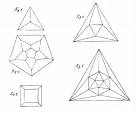Rampage
In this episode, a shooter attacks the FBI office and Charlie and the
FBI team try to find out why.
Inequality Bounding
At the beginning of the episode, Charlie
explains how to understand the connecting between a child molestor and
his victim by looking at the intersection of the areas that each person
uses. A very simple example is assuming that both the victim and
perpetrator move in circles of radii r1 and r2
centered at
(x1,y1) and (x2,y2).
Activity 1: Finding the area of
the intersection of two circles.
The following steps would allow you to find a formula to compute the
area intersection of the intersection of two circles, say
with radii r1,r2
and centered at (x1,y1) and (x2,y2).
1. Draw a picture of two
circles with radii r1 and r2,
and centerd at
C1=(x1,y1) and C2=(x2,y2).
Draw the circles so the area of intersection
is not zero. Also, name the intersection points I1 and I2.
2. What is the distance between P1 and P2? Call
this distance D.
3. Find the angles I1C1I2 and I1C2I2.
[Hint: Use the law of cosines to
get I1C1C2 and notice that I1C1I2=2I1C1C2.
Do likewise for I1C2I2]
4. Make sure the angles are expressed in radians.
5. Find the area of the circular sectors I1C1I2
and I1C2I2 [Hint:
Recall that the area of a circular sector is given by

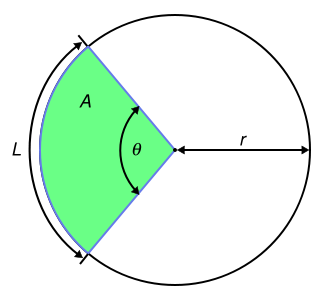
6. Find the area of the triangles I1C1I2
and I2C2I2.
7. Deduce a formula for the area of the intersection of the two circles.
8. Agoat is tied to a point on the perimeter of a
circular field of radius 8 ft. The length of the rope is 2 ft. What is
the area
of the field accessible to the goat?
Brownian Motion
Analizing the path taken by the shooter in the FBI building, Charlie
noticed that the path describes was a Brownian path. Basically,
Brownian motion refers to
the random movement of a particle in a fluid. A nice computer
simulation can be found in this link.
This concept was introduced by the Scottish botanist Robert Brown (1773
- 1858) who used his microscope to look at pollen floating in
water. He noticed that the pollen grains moved in a very unpredictable
way, and the same occurred with other very small particles. He assumed
that the movement was due to physical causes (and in fact it is now
know that this unpredictable movement is due to the bombardment of the
water molecules). Albert Einstein
used Brownian motion to (indirectly) confirm the existance of molecules
and atoms, while the mathematician Louis Bachelier
used Brownian motion to analyze the stock market (stock options) in the
first paper to used advanced mathematics to study finance.
Loop-erased Random Walk
Trying to understand the
perpetrator's path in the FBI rampage, Charlie used the concept of
loop-erased random walk. To describe the concept, suppose one has a
graph G and selects a path in
G; that is, a collection of vertices v1, v2,
. . ., vn such that
two consecutive vertices form an edge in G. This path may contain
loops (a path where the
initial and end point are the same). A loop-erased random walk in G is
the a path where the loops
have been removed chronologically.
Activity 2
- Consider the picture below the picture above, suppose a path is
given by 1,3,4,5,5. What would be the loop-erased walk
corresponding to that path?
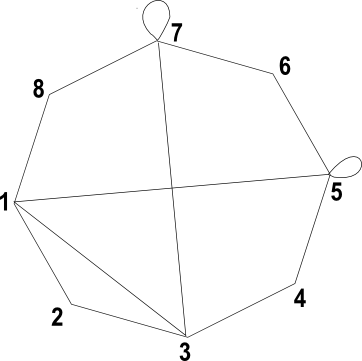
- What if the path is 1,2,3,4,5,6,7,7,3,7?
- A spanning tree of a graph G is a tree
(a graph
with no cycles) whose vertex set is the
same as G’s. How many spanning trees does the graph above have?
Tesseract and Schlegel Diagrams
As pointed out in the episode, a
tesseract is a 3-dimensional
representation of the 4 dimensional cube. A tesseract is an example of
a Schlegel diagram, invented
by the German mathematician Victor Schlegel (1843-1905). A Schlegel diagram encodes a d-dimensional polytope (a polyhedron in more
than 3 dimensions) into a an object of dimension d - 1. To draw a Schlegel diagram,
follow the following steps:
1. Pick a face F and a point P "outside" the center of F (see picture
below).
2. Draw lines between the point P and all the vertices of the figure.
3. Mark the points where these lines intersect F.
4. Imagine F is made out of rubber bands, and move the vertices to
their intersection in F. The edges outside F will correspond to lines
connecting the intersections in F.
The resulting picture is the Schlegel diagram. The example below
describes the construction of the Schlegel diagram of the tetrahedron.
Here the edges outside F are A, B, and C, and they correspond to A, B,
and C, respectively, in the red figure. Notice that the actual Schlegel
diagram depends on our choice of F. In the case of the tethrahedron,
since all the faces have the same shape, the choice of F is irrelevant.
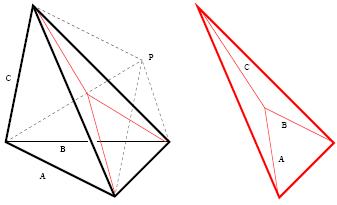
These are the Schlegel
diagrams for the
platonic
solids, appearing in Schlegel's original paper.
Activity 3
- Draw the Schlegel diagram of a
3-dimensional cube.
- Draw the Schlegel diagram of the triangular prism depicted
below.
First use one of the triangular faces, and then use one of the
rectangular ones. You should get different diagrams.
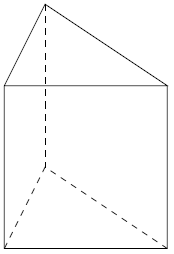
- Convince yourself that a tessaract is in fact the Schlegel
diagram
of the 4-dimensional cube. Looking back at 1. above may help.


